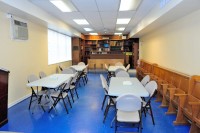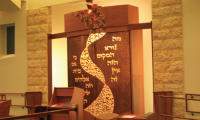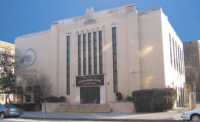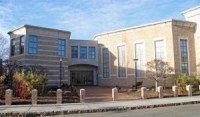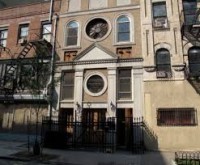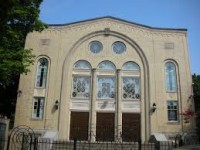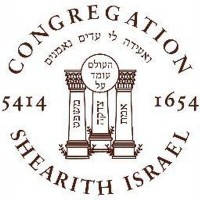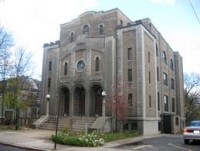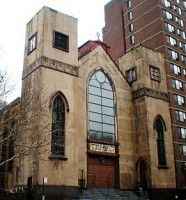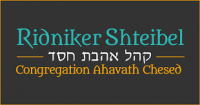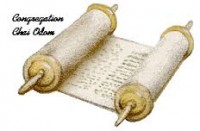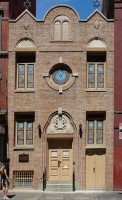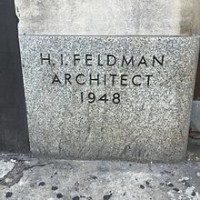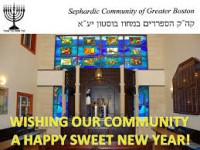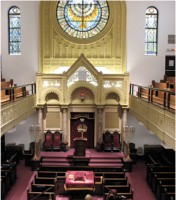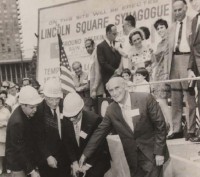Welcome to the website of Young Israel of New Hyde Park. Located on the Queens/Nassau border we offer the best of suburban and city life, in a heimishe atmosphere. A vibrant membership of all generations contributes to the feeling of family for new arrivals and visitors alike. It's a shul where everybody knows your name. Being an Orthodox Shul in northeast Queens, YINHP plays a central role in increasing the presence and awareness of Orthodoxy in our community. Our Mikveh is our largest undertaking towards this goal and was completed in April 2013.
For more than half a century, the Young Israel of New Hyde Park has provided, and continues to provide, members and visitors with many of the things that an Orthodox family looks for and needs – daily minyanim, classes, and a newly renovated sanctuary that has received rave reviews from members and visitors alike. There is a community-wide eruv that has recently expanded into Lake Success.
We are most proud of our local school, Yeshiva Har Torah which is an outstanding modern orthodox day school with a new state-of-the-art facility, serving pre-K through 8th grade. Busing to all of the familiar yeshiva high schools is available as well.
The saying goes "location, location, location" and frankly you can't beat ours. The area features one fare bus and subway access and/or, express bus service to Manhattan, is a short hop to the LIRR and if you travel by car, is literally seconds away from the Northern State, Grand Central and Cross Island Parkways as well as the Long Island Expressway.
Shopping is a pleasure as within a couple of mile radius you have your pick of three major supermarkets, all of which feature a wide range of kosher products. For a more specialized kosher shopping experience we are moments away from Mazurs Glatt Kosher Butcher and Marketplace. Tired from all that shopping? Stop off for a bite at our local kosher pizza place, Green Olive, a delicious oasis right in the heart of our community.
Located around the corner from Long Island Jewish Medical Center, Zucker Hillside Hospital and Cohen Children's Medical Center as well as Parker Jewish Institute for Health Care and Rehabilitation (all of which are within our eruv ), the Young Israel of New Hyde Park has long been known as a place where the family and friends of patients can find the religious support they need and Shabbat and Yom Tov hospitality.
Davening Times
Weekday Times 2/7-2/13
Shacharit-Su 8:10 am
Shacharit-MTh 6:10 am
Shacharit-TuW 6:05 am
Shacharit-F 6:15 am
Latest Shema 8:55/9:31 am
Mincha/Maariv 5:05 pm
Shabbat Times Teruma
Friday Mincha 5:10 pm
Candle Lighting 5:07 pm
Shacharit 8:45 am
Mincha 5:00 pm
Shabbat Ends 6:11 pm
We are a Modern Orthodox synagogue located in beautiful Newton Centre, Massachusetts, in the greater Boston area.
Our small, energetic shul aspires to provide an inclusive, friendly, and participatory atmosphere conducive to personal growth through tefillah, tzedakah, Torah study, serious religious expression, and building a supportive community of values and meaning.
As our Sages taught us so long ago: The world stands on three things: Torah, Avodah, Ug'milut Chasadim. At Shaarei, we too stand on — and just as importantly, we stand for — these three foundational pillars.
In January of 2014, the Orthodox Union recognized our synagogue as a Hineinu Synagogue, an exemplary national model of communal inclusivity. Our Shul’s inclusivity statement follows:
We are excited to partner with the Hineinu initiative of the Orthodox Union. At Shaarei Tefillah, we pride ourselves on our warm, welcoming Modern Orthodox community. However, we have learned over the years that creating an inclusive environment requires more than good will. A sincere call for inclusivity must be conveyed not only with greetings and invitations, but must be expressed through architecture and access, signage, wordage and programs. The strength of kehillah (community) should be measured not only in membership units and the length of weekly announcements, but also by our manifest inclusivity and our capacity as a halakhic community to learn and improve, to outreach and in-reach, to grow together through full encounter of Torah uMitzvot. When we built our new Shul building just a couple of years ago, a vision of inclusivity drove our process. We designed our Shul to communicate through structure and form that our Beit Kenesset, our home of spiritual ingathering, invites and values the participation of men and women, adults and children, abled and disabled, empty nesters and young families, frum-from-birth and newly religious seekers. We work hard to concretize this message through our programming and publicity as well. Joining the Hineinu initiative is our way of continuing to respond to this Divine call and charge of hakhel, of inclusivity. We sincerely hope that by stepping up to say “Here We Are,” we will inspire other Shuls to do likewise and invite those who have previously felt without community to join us with their own “Hineini — Here I am.”
The Philosophy
Chabad-Lubavitch is a philosophy, a movement, and an organization. It is considered to be the most dynamic force in Jewish life today.
Lubavitch appropriately means the “city of brotherly love”The word “Chabad” is a Hebrew acronym for the three intellectual faculties of chochmah—wisdom, binah—comprehension and da’at—knowledge. The movement’s system of Jewish religious philosophy, the deepest dimension of G‑d’s Torah, teaches understanding and recognition of the Creator, the role and purpose of creation, and the importance and unique mission of each creature. This philosophy guides a person to refine and govern his or her every act and feeling through wisdom, comprehension and knowledge.
The word “Lubavitch” is the name of the town in White Russia where the movement was based for more than a century. Appropriately, the word Lubavitch in Russian means the “city of brotherly love.” The name Lubavitch conveys the essence of the responsibility and love engendered by the Chabad philosophy toward every single Jew.
Following its inception 250 years ago, the Chabad-Lubavitch movement—a branch of Hasidism—swept through Russia and spread in surrounding countries as well. It provided scholars with answers that eluded them, and simple farmers with a love that had been denied them. Eventually the philosophy of Chabad-Lubavitch and its adherents reached almost every corner of the world and affected almost every facet of Jewish life.
No person or detail was too small or insignificant for their love and dedicationThe movement is guided by the teachings of its seven leaders (“Rebbes”), beginning with Rabbi Schneur Zalman of Liadi of righteous memory (1745–1812). These leaders expounded upon the most refined and delicate aspects of Jewish mysticism, creating a corpus of study thousands of books strong. They personified the age-old Biblical qualities of piety and leadership. And they concerned themselves not only with Chabad-Lubavitch, but with the totality of Jewish life, spiritual and physical. No person or detail was too small or insignificant for their love and dedication.
In our generation, the Lubavitcher Rebbe, Rabbi Menachem Mendel Schneerson of righteous memory (1902–1994), known simply as “the Rebbe,” guided post-holocaust Jewry to safety from the ravages of that devastation.
The origins of today’s Chabad-Lubavitch organization can be traced to the early 1940s, when the sixth Lubavitcher Rebbe, Rabbi Yosef Yitzchak Schneersohn of righteous memory (1880–1950), appointed his son-in-law and later successor, Rabbi Menachem Mendel, to head the newly founded educational and social service arms of the movement.
Today 4,000 full-time emissary families direct more than 3,300 institutions Motivated by his profound love for every Jew and spurred by his boundless optimism and self-sacrifice, the Rebbe set into motion a dazzling array of programs, services and institutions to serve every Jew.
Today 4,000 full-time emissary families apply 250-year-old principles and philosophy to direct more than 3,300 institutions dedicated to the welfare of the Jewish people
The Queens Jewish Center, also known as Queens Jewish Center and Talmud Torah or QJC, is a synagogue in Forest Hills, Queens, New York known for its significant contributions to the Jewish community. The synagogue was established by a dozen families in 1943 to serve the growing central Queens Jewish community.The current spiritual leader is Rabbi Simcha Hopkovitz.
The Queens Jewish Center building won honorable mention in the 1955 Queens Chamber of Commerce, Annual Building Awards. The architect was David Moed of Manhattan and the Builder was the LeFrak Organization.
The structure actually consists of two separate buildings. On October 3, 1946 an option was taken on the vacant plot where both Synagogue buildings now stand. Ground was first broken for the first building (also referred to as the Talmud Torah building or Bais Hamedrash building) during an elaborate ceremony on June 5, 1949, by Judge Paul Balsam and Center President Herman A. Levine. The ground-breaking for the Main Synagogue building took place on June 21, 1953 and was made possible by generous benefactor, Mr. Harry
Neighborhood
· Forest Hills was once the home of the US Open tennis tournament, played at the West Side Tennis Club before it moved to the USTA National Tennis Center in Flushing Meadows Park. When the Open was played at the tennis stadium, the tournament was commonly referred to merely as Forest Hills just as the British Open was referred to as Wimbledon.
· The neighborhood boasts a beautiful aura of old English infrastructure.
· The feeling of the neighborhood is a safe one. Conclusive for a healthy lifestyle , in mind body and spirit.
· It’s pretty picturesque scenery make it perfect surrounding for simply, better living.
· Only minutes away from the Mile long Austin street Shopping strip. As well as the large array of shopping opportunities of Queens Blvd and the boutique style antique shops of Metropolitan Ave. Truly a garden , to live in.
The Young Israel of Brookline is one of the largest Orthodox congregations in New England. The congregation was founded in 1953 and our earliest services were held in a small house on Fuller Street. When we quickly outgrew the space, member families purchased a larger site a few blocks away, on Green Street. In January 1994, when an electrical fire destroyed our shul building, our services and programs moved down the block, to a re-converted office building which we used while our new shul, shown above, was under construction. With great joy, the Young Israel community dedicated the new synagogue in November, 1996. The new facility hosts a main sanctuary which seats 525 congregants, beit midrash and Judaica library, banquet hall, kosher catering facilities, bridal room, classrooms, offices, keilim mikveh, and permanent sukkah structure.
Our members are a diverse group consisting of student couples, individuals, and families. Since Brookline is within walking distance of area hospitals, and a short drive to many universities and high-tech companies, it’s a popular destination. Many of our members are trained in the sciences, including the medical, software and engineering fields, and play leadership roles within their respective organizations. Also, since Boston is home to many top hospitals, we tend to see people from around the world, including many from Israel.
Your most heroic acts are those of which you may not even be aware.
Like the time you could have gotten even with the guy in the next cubicle, and nobody would have known. And you really wanted to. But you didn’t, just because it’s not right.
You may not have been impressed—you may even have been disappointed with yourself. But the angels burst into song, as all your world rose up a notch. It may have been the most elevating act of a lifetime.
Heroic acts are not heroic if they’re second nature. It’s when you break out of your nature that you enter the realm of the divine.
B"H We are all heros. We are all filled with the glory of God.
The difference between "the best of us and the worst of us" is a VERY fine line and moves with time.
Redemption and return to God is just a moment and thought away. A desire.
Rv. Freeman, the lessons are from God, with your sweet expression.
Thanks to God, through you on this Thanksgiving day.
Shalom,
how great to know that not only in general we are important, but every moment of our life!! we are the main actor and HASHEM is our main audience and our "Oscar" is His approval and joy.
We’re doing something special for Purim this year, and the more of you participate, the more special it will be! Sign up for our first-everMishloach Manot Project to send your friends and fellow Stanton members traditional Purim food baskets. We prepare them for you, you sit back and enjoy Purim, proceeds go to the shul, and everybody wins!
How does it work? You should already have received an e-mail with instructions and your very own log-in code. Simply log-in to the Purim Project site and select the people you want to send to from the list of participants ($5/person or $180 for as many names as you want). The baskets will be available to be collected at the shul on Purim night,March 23, and Purim morning, March 24, when you come for megillah reading. (Please note, each participant receives one basket with a list of all the people who gave to them.)
We are honored to host the Honorable Martin Shulman this Shabbat, February 6, for a special talk in honor of Parashat Mishpatim (Laws). Judge Shulman’s talk on “Selected Torah and Secular Social Laws – No Need to Re-invent the Wheel,” will take place at 12:15pm, after kiddush, and will be followed by mincha. All are welcome!
Celebrate Shabbat with Stanton and the rest of America next week!
We will be having a community Shabbat dinner on Friday night,March 4, for the nationwide Sabbath observance known as Shabbat Across America. Click here to sign up now! The cost is $35/person or $30 for shul members. Sponsorships of $100 include dinner for two. Please let us know if you would like a vegetarian entree.
Temple Beth Shalom, also known as the Tremont Street Shul, is a warm, friendly, traditional Jewish synagogue located near the center of Cambridge, Massachusetts. We embrace a wide variety of ages, backgrounds, and styles of worship. On Shabbat evening and morning we have two styles of services. Shabbat morning services are followed by a sit down Kiddush lunch to which everyone is welcome.
HISTORY
Temple Beth Shalom was formed when Temple Ashkenaz and Congregation Beth Israel merged in 1962. The merged Shul chose to use the Temple Ashkenaz building at 8 Tremont Street because it was newer. The name was changed to Temple Beth Shalom, in part to mark a new spirit of community cooperation.
As members of the original Cambridge Jewish community migrated to the suburbs, the synagogues in Cambridge consolidated in stages. The Tremont Street Shul was the last of original Shuls to remain in operation. In the 1970’s, all the local colleges decided to have a joint Simchat Torah celebration at TBS. Helped by the success of this annual event, the Shul began to attract new members from the young professionals in the greater Cambridge area and has grown steadily since then.
Our Shul underwent a major renovation in 1987. The basement vestry was made suitable for the Alef Bet child care center, which was founded at that time. A second renovation in 1994 transformed our balcony into a convertible classroom. A new office was added in 2004. Meticulous care was taken during each renovation to conserve our building’s historic character. We think our main sanctuary is one of the Jewish architectural jewels of the greater Boston area. Come and see for yourself!
The ancestors of Temple Beth Shalom include:
Congregation Anshai Sfard, organized 1896, chartered 1898, building at 83 Webster Ave., Somerville, merged into Beth Israel 1957
Congregation Beth Israel, organized 1900, building at 238 Columbia St.
Temple Ashkenaz, split off from Beth Israel over the issue of Ashkenazic vs. Sephardic ritual 1908, building at 8 Tremont St.– originally the home of Joshua Kaplan, house torn down and a new building erected 1924
Congregation Yavneh, chartered 1918, building at 8 Howard St. erected 1920, closed 1934.
For more information on our history and the history of Jews in Cambridge, see our on-line exhibit Centennial of the Jewish Community in Cambridge, an event we celebrated in 1996.
Temple Beth Shalom is a member of the Synagogue Council of Massachusetts.
ABOUT US
Reflecting the diverse population of Cambridge, Temple Beth Shalom represents a unique, creatively traditional approach to Judaism. Our goal is to make Jews of every affiliation feel at home. Impossible? Try us.
We have three styles of worship every Shabbat and two styles of weekday services. See the worship services page for more information on the styles available. Our minyanim come together later Saturday morning for a sit-down Kiddush. Our Kiddush includes a light lunch, singing, and much fellowship. All holidays are celebrated with services and appropriate observances.
We have an active 20s and 30s group that runs several social events every month.
The Temple hosts a number of educational activities, including the Alef-Bet Child Care, a Talmud class, and other adult education programs. Along with two other local congregations we support the Kesher after-school Hebrew School program.
A unique event at Beth Shalom is our famous erev Simchat Torah celebration which draws as many as 500 or more people. Part of the fun-filled service is the Hakafot, which takes the congregation out onto Tremont St. for singing and dancing well into the night. This service attracts a wide cross-section of the Greater Boston community, including special participation of local college Hillels.
קהילת שארית ישראל נוסדה במנהטן, ניו יורק בשנת 1654, על ידי מגורשי ספרד ופורטוגל, ונחשבת לקהילה היהודית הוותיקה בארצות הברית. בית הכנסת של הקהילה, המכונה גם "ספרדי-פורטוגזי" ("Spanish and Portuguese"), מתפקד כאורתודוקסי. ממוקם ברחוב 70 (מערב), ניו יורק.
הקהילה נוסדה ב-1654 על ידי 23 מהגרים יהודיים, שבאו מברזיל, ונחשבת לקהילה היהודית הממוסדת הראשונה בארצות הברית.[דרוש מקור] במשך השנים, השתתפו חברי הקהילה במאבק למען זכויות אזרחיות ליהודי ארצות הברית, ובהדרגה השיגו את מבוקשם. מכיוון שהקהילה הייתה הקהילה היהודית היחידה בעיר ניו יורק עד שנת 1825, שארית ישראל תפקדה בתור המרכז של החיים היהודיים, סיפקה מקום לתפילה ולימוד – הן חילוני והן תלמוד תורה, כמו גם מקום לשירותים דתיים (אוכל כשר, מקווה וכו') ומפגשים חברתיים.
Weekday Services January 31 – February 5, 2016 5776 – Mishpatim – Sunday – Friday – January 31 – February 5, 2016
SCHEDULE
Morning Services
Sunday 8:00 am
Monday – Friday 7:15 am
Sunday – Thursday 6:30 pm
Shabbat Services February 5 – 6, 2016 Mishpatim – 5776 – Friday Eve & Saturday – February 5 – February 6, 2016
SCHEDULE
Friday
Candle Lighting 5:00 pm
Services 5:00 pm
Saturday
Morning Services 8:15 – 11:45 am
Torah Reading: Mishpatim
Seuda Shelishit & Class 3:55 pm
Minhah & Arbit 4:55 pm
Sunset 5:19 pm
Habdalah 5:48 pm
Congregation Talmud Torah Adereth El was established in 1857. It has the distinctionof being New York's oldest synagogue in its original location with continuous services. Founded four years before the Civil War, the history of Adereth El is intertwined with thatof New York City. Rabbi Sidney Kleiman OB"M served as the Rabbi of Congregation Talmud Torah Adereth El from 1939 – 1999. He continued attending services daily as Rabbi Emeritus until his passing at the age of 100 in the Spring of 2013. For more than a decade, Rabbi Gideon Shloush has infused the shul with his energy and creativity, and Adereth El is experiencing a wonderful renaissance. The Synagogue plays a vital role in New York's Jewish community. Adereth El serves the neighborhood through daily prayer services, weekly learning and outreach programs, an array of Shabbat activities, welcoming guests from around the world, providing assistance to those with loved ones in area hospitals
Adereth El's current membership reflects the diversity of its neighborhood, Murray Hill. During the work week, many Jewish businessmen with nearby offices pray at the synagogue. The congregation now includes a number of young, single members due to the growing popularity of Murray Hill with this population. Of note, many Adereth El members are students and faculty at the nearby New York University (NYU) medical center. The synagogue’s proximity to the hospital also brings in many hospital patients’ visitors as guests at Adereth El services. In fact, the synagogue typically has multiple weekly baby-naming ceremonies due to the large number of labor and delivery visitors. Additionally, due to Adereth El’s location near Yeshiva University’s Stern College for Women, many Stern students regularly attend the synagogue’s services.
The history of Congregation Adereth El is quite colorful and gives us an opportunity to look at the life and times of a Congregation as it struggles and grows in the most exciting city in the world. It is a reflection of the progress and accomplishments of New York Jews for 150 years. It is also an opportunity to look at and remember the names of men and women who have come and gone and yet whose mark lives on in the energies they gave to the Synagogue they loved.
The Text was written by Rabbi Sidney Kleiman and Andre S. Marx to be included in the 100th Anniversary Journal that was distributed at the Waldorf-Astoria Hotel on October 27, 1957. Not only did the authors undertake the massive job of reviewing the records and minutes of a century's worth of meetings, but it is obvious that they also did extensive field investigation in the community and at the records offices of New York City.
In 2013, we celebrated the 125th anniversary of the founding of the earliest of the Boston Synagogue’s predecessor shuls — Congregation Beth Jacob, founded in 1888. To celebrate this momentous occasion, the Synagogue Board formed an Archival/Historical Committee, which wrote a 260-page history book. It is the most authoritative history ever written about the synagogues of the West End. The book is available for purchase directly from the Synagogue, as well as on Amazon.com.
Much of what we have uncovered is quite fascinating and not widely known. Parts of it are funny — like the story of how some disgruntled Kosher butchers and a rejected suitor poisoned all 2,000 guests at the wedding of a rabbi’s daughter. Fortunately, no one died. We also interviewed former West End resident Leonard Nimoy, who among other things told us that the famous Vulcan salute comes from the priestly blessing that he observed as a teenager at one of our predecessor synagogue’s High Holiday services.
In some ways, the story of Boston Synagogue is the story of Boston generally: substantial growth due to immigration at the turn of the 20th century; followed by a long period of urban decline; then substantial resurgence as downtown Boston has become an increasingly attractive place for people to live. As such, we celebrate not just our synagogue, but also the entire downtown Boston community of which we are a part.
A few years ago, we established guidelines for adding artwork that complements the building’s modern design. We commissioned a new ark curtain designed by Joy Chertow, an art teacher at Solomon Schechter Day School in Newton, MA. The intricate and ornate quilting was done by Elana Schreiber, a science teacher at Schechter. The curtain was donated by Mark Schonfeld in memory of his late wife, Bobbie.
After numerous compliments about our ark curtain, we decided to commission a new wall hanging for our lobby entryway, in memory of our longstanding member Florence Wasserman. The Etz Hayim (tree of life) design with a representation of the city of Jerusalem, also designed by Joy Chertow, was chosen to represent the continuing attachment of generations of Jews worldwide to the land of Israel.
wallhangingAs part of our 125th anniversary, we created a high-resolution scan of the 1909 North Russell Street Mishna Society hand-illuminated cover page, and then created a set of enlargements from this work that now grace the sanctuary. It is a beautiful blend of the traditional and modern!
Not to be confused with Beth Hamedrash Hagadol Anshe Ungarn, "Great House of Study of the People of Hungary", a Lower East Side congregation founded in 1883 by Hungarian Jews.
Beth Hamedrash Hagodo: בֵּית הַמִּדְרָש הַגָּדוֹל, "Great Study House "is an Orthodox Jewish congregation that for over 120 years was located in a historic building at 60–64 Norfolk Street between Grand and Broome Streets in the Lower East Side neighborhood of Manhattan, New York City. It was the first Eastern European congregation founded in New York City and the oldest Russian Jewish Orthodox congregation in the United States.
Founded in 1852 by Rabbi Abraham Ash as Beth Hamedrash, the congregation split in 1859, with the rabbi and most of the members renaming their congregation Beth Hamedrash Hagodol. The congregation's president and a small number of the members eventually formed the nucleus of Kahal Adath Jeshurun, also known as the Eldridge Street Synagogue. Rabbi Jacob Joseph, the first and only Chief Rabbi of New York City, led the congregation from 1888 to 1902.Rabbi Ephraim Oshry, one of the few European Jewish legal decisors to survive the Holocaust, led the congregation from 1952 to 2003.
The congregation's building, a Gothic Revival structure built in 1850 as the Norfolk Street Baptist Church and purchased in 1885, was one of the largest synagogues on the Lower East Side. It was listed on the National Register of Historic Places in 1999. In the late 20th century the congregation dwindled and was unable to maintain the building, which had been damaged by storms. Despite their obtaining funding and grants, the structure was critically endangered.
The synagogue was closed in 2007. The congregation, reduced to around 20 regularly attending members, was sharing facilities with a congregation on Henry Street The Lower East Side Conservancy was trying to raise an estimated $4.5 million for repairs of the building, with the intent of converting it to an educational center. In December the leadership of the synagogue under Rabbi Mendel Greenbaum filed a “hardship application” with the Landmarks Preservation Commission seeking permission to demolish the building to make way for a new residential development. This application was withdrawn in March 2013, but the group Friends of the Lower East Side described Beth Hamedrash Hagodol's status as "demolition by neglect"
Shacharis (Mon-Fri) 7:15 am
Shacharis (Sunday) 8:15 am
Rosh Chodesh Shacharis 7:00 am
Daf Yomi (Mon-Fri) 6:30 am
Daf Yomi (Sunday) 7:30 am
Women’s Tehillim Group (every Wednesday) 9:00 pm
About Us
Congregation Ahavath Chesed is an Orthodox synagogue which was founded in 1944 and has remained in its original location on Manhattan’s Upper West Side since then. It was originally established by Rabbi Binyomin Halberstam זצ”ל, formerly Rabbi of Rudnik, Poland. From the outset, the intent was to recreate the ambiance and authenticity of the countless community shteibels that were essential to Jewish existence throughout Europe before World War II. Rabbi Halberstam sought to introduce this type of institution to post-war Manhattan as a refuge for worshippers who were then immigrating to America and for the benefit of the resident population.
Rabbi Halberstam was the driving force behind the Shul for the next two decades. He was succeeded in the mid-1960s by his son-in-law, Rabbi Shmuel Orenstein זצ״ל, who served as Rabbi with extraordinary distinction until his passing in 2006. Since Rabbi Orenstein’s passing, the Shul continues to draw inspiration and direction from the lessons that he taught during his lifetime. Recently, the membership of the Shul funded a very substantial endowment in memory of Rabbi Orenstein. The endowment will be utilized to finance Jewish scholarship that is consistent with his ideals.
During the past few years, there has been substantial growth in the membership and activities of the Shul. The daily Morning Prayer services have increased participation and the Shabbos morning service is particularly well attended. The Shabbos service is followed by a hot Kiddush providing time for the members to socialize and welcome new participants.
The Shul is presently embarking on a much needed renovation of its building on West 89th Street with the objective of enabling the facility to support the growing membership and the increasing number of Shul programs over the course of the next decade.
His love for his fellow man was genuine – you felt it and reciprocated in kind. Every word of Torah was precious. He would sit and think at length about any given passage. If a difficult question was posed to him, it could set off a thought process that could last hours until he responded with an answer that was breathtaking in its precision and clarity. He enjoyed people – especially young people with fresh ideas. When he reflected on his life history, you were transported back in time. You were taken to Vilna, Pinsk, Siberia, Lodz, and of course to Boston and Bnei Brak. His love for Eretz Yisrael was not based on politics or government, but was the essence of a dream to come and walk the same land tread upon by our forefathers. In fact, he was a minister without portfolio – constantly encouraging others to make Aliya. He gave respect to others, regardless of their age. In Bnei Brak, he would not move without the direction given by the illustrious Rav, Rav Yitzchak Zilberstein, Shlita.Looking back, Rebbetzin Chava Margolis a”h, was half his life. The mutual admiration was something unique to our struggling generation. It was because of this mutual respect that they were able to build and maintain and accomplish all they did.
We here in Boston were privileged to have him with us for a large part of his life. Our vibrant shul is the result of his life's work. The Mesivta of Greater Boston is named for him and his Rebbetzin, because the donor, Mr. Yitzchak Selib a”h, was befriended and educated by him. Mr. Selib also was a major donor to the Kollel, enabling them to stand on firm financial ground. For years, Rav Margolis nurtured donors for New England Hebrew Academy. He was a strong advocate for the Bais Yaakov for many years. He and his children were instrumental in the founding of Torah Academy. He founded the N'shei Agudas Yisrael which functioned successfully for many years. Agudas Yisrael of Boston, under his leadership, was the address for many great leaders of Klal Yisrael. A fruitful and productive time in Boston was followed by his move to Eretz Yisrael. It was an act of Divine Providence that he found himself in the presence of one of the great personalities of the Jewish world – Rav Yitzchak Zilberstein Shlita, son-in-law of Rav Elyashiv Ztz”l, and one of the foremost Poskim in the world. Although much younger than Rav Margolis, their mutual respect was something to behold. He referred to Rav Margolis as “Pe’er HaShchuna” the crown of the neighborhood. Rav Margolis began to give lectures in Mussar. The Sefer of the Alter of Navordok – Madreigas HaOdom – became well known in Ramat Elchonon. He acquired many friends and students – most of them many years younger than him.
Towards the end of his life he suffered a few strokes, but always displayed signs of mussar and yiras shamayim.
On the 14 of Shevat, the light of this magnificent neshama was darkened, and we are left with the memories. He was a bridge to the past, and left us with a path to the future.
To you all, I wish a happy and healthy year.
קהילה קדושה יאנינה הוא בית כנסת הנמצא ברחוב ברום (Broome) 280 בין רחובות אלן (Allen) ואלדרידג' (Eldridge) בלואר איסט סייד במנהטן ניו יורק. הוא נבנה בשנים 1925-1927 ותוכנן על ידי סידני דאוב. הוא בית הכנסת היחיד בחצי הכדור המערבי שנוהגים בו בנוסח הרומניוטים השונה גם מנוסח אשכנז וגם מנוסח ספרד.
לקהילה קדושה יאנינה יש ייחוד בהיותו בית הכנסת הרומניוטי היחיד בחצי הכדור המערבי הקהילה נוסדה ב-1906 על ידי מהגרים יהודי יוונים מיואנינה, אבל בית הכנסת לא הוקם עד 1927. השנים מאז ועד מלחמת העולם השנייה היו שנים של שפע לקהילה הרומניוטית בלואר איסט סייד. כיהנו בבית הכנסת שלושה רבנים ובימים הנוראים היה בית הכנסת מלא מפה לפה. אחרי מלחמת העולם השנייה עבר חלק גדול מבני הקהילה לרבעים אחרים וחלקים אחרים של מנהטן כולל הרלם, ברונקס וברוקלין. קהילות אלה כבר אינן פעילות היום. למרות שהקהילה התמעטה באופן קבוע מאז ימי הזוהר שלה לפני המלחמה הרי עדיין מתקיימות תפילות בבית הכנסת בשבתות ובחגים. למרות שיש לבית הכנסת רשימת תפוצה של 3,000 אנשים הרי, לעתים קרובות, חסרים אנשים למניין בתפילות השבת. סיורים מודרכים מתקיימים בכל יום ראשון למבקרים. לקהילת יאנינה יש חלקה בבית העלמין בוולווד (Wellwood). שם יש גם מצבת זיכרון ליהודי יאנינה שנספו בשואה.
הבניין נוסף לרשימה הלאומית של מקומות היסטוריים ב-30 בנובמבר 1999 וצוין כנקודת ציון של העיר ניו יורק ב-11 במאי 2004 . הוא עבר שיקום נרחב ב-2006.
Congregation Kehila Kedosha Janina
A small synagogue in New York City's Lower East Side is reaching out to make people aware of its congregation's heritage through a museum that familiarizes people with its customs and history.
The synagogue is virtually unchanged since being built in 1927 by Romaniote Jews from Janina, Greece. In 2004, it was designated a landmark by the City of New York.
Both memorabilia and the museum's tour guides describe the story of the Romaniote Jews, from their entry into Greece in the first century to their current life in America.
Differences between Greek Romaniote Jews and the Greek Sephardic Jews who fled from Spain to escape the Inquisition are featured: The two groups speak different languages and have distinct customs.
The synagogue is open for Shabbat services at 9:00 a.m. and on holidays. Look for the schedule of "Holiday Services" on our sidebar menu.
The Museum is open from 11:00 a.m. to 4:00 p.m. on Sundays, or please contact us if you wish to have a special appointment.
The synagogue was supported by the many millinery organizations that were based in the neighborhood. A group of these ready-to-wear industry business men had been meeting in various spaces, mostly in a loft on West 36th Street. Their rabbi during this very loosely organized time was Rabbi Moshe Ralbag. In January 1933, the congregation was more formally organized and the name of the synagogue, the Millinery Center Synagogue, was agreed upon, although the meeting place was temporary, at 1011 Sixth Avenue, on the second floor. Moe Brillstein (the father of film producer Bernie Brillstein) became president and started a building fund. At that point the congregation came together and decided to build a synagogue.
Due to the density of millinery businesses in the neighborhood, at its peak, services for daily minyan were typically so heavily attended that the prayer sessions were held in rotating shifts.
The synagogue was built by H.I. Feldman a prolific, Yale-educated architect who built thousands of Art Deco and Modernist-style buildings in New York City,notably 1025 Fifth Avenue (between 83rd and 84th Streets) on the Upper East Side and the LaGuardia Houses on the Lower East Side, as well as many buildings that line the Grand Concourse in the Bronx. Feldman and his company, The Feldman Company, also built the Federation of Jewish Philanthropies building (130 East 59th Street) and the United ewish Appeal building (220 West 58th Street).
There were wartime restrictions on building, so building was postponed for a time until 1947. The building's construction was completed in September 1948, and the synagogue was dedicated on September 12, 1948.
History
SEPHARDIC COMMUNITY OF GREATER BOSTON
The Sephardim, the first Jewish community to reach America in 1492 together with Christopher Columbus, have been living in Boston for over 350 years. They arrived around the same time as the city of Boston was incorporated in the year 1630. Spanish Portuguese Jews escaping the inquisition and persecution, settled throughout the English Colonies, regaining their freedom of religion, and building their homes and businesses. The first documented Jew in Boston was Solomon Franco, a Sephardic Jew from Holland, who arrived in 1649.
Among the famous patriots living in Boston, was Moses Michael Hays, a Portuguese Sephardi. He and his family left Newport for Boston ahead of the British attack in 1776, at a time that Boston was devastated by the physical and financial effects of the American Revolution. For the next three decades, Moses Hays and his family would play key roles in establishing the financial and cultural institutions that would define post-Revolutionary and 19th-century Boston.
He opened a shipping office in Boston and was among the first merchants there to underwrite shipbuilding, trade and insurance to newly opened Far Eastern markets. In 1784, Hays become a founder and the first depositor of the Massachusetts Bank still doing business today as part of the Bank of America. He was an honorary member of the Boston Marine Society, and a founder of the Mass Mutual Fire Insurance Company and the Mass Marine Insurance Company.
Moses Hays was also active in a variety of civic projects. He donated to subscriptions to beautifying the Boston Common, to building bridges and turnpikes, and to Harvard College.
His son, Judah Hays, and his nephews, Abraham and Judah Touro (after whom Touro Synagogue in Newport, RI, the oldest synagogue in America is named) continued in his tradition. They helped establish Mass General Hospital (Abraham Touro’s portrait is on the wall, in the main lobby), the Boston Athenaeum and the Bunker Hill Monument (The base of the Bunker Hill Monument bears an inscription honoring Judah Touro).
Besides socializing with Paul Revere and Harrison Gray Otis, these Sephardic families were sincere to their Jewish roots. Their businesses were closed on Shabbat, kosher meat was being delivered from Newport, regular prayer services were being held at their homes, and their household library contained dozens of Hebrew books.
However, with all prosperity, the early Boston Sephardic Jews were considered alien-residents. No Jewish houses of worship were allowed in Boston. Furthermore, the Hayes, Touro, Lopez and many other Boston Sephardic families had to bury their deceased in Newport, since there were no Jewish cemeteries allowed at that time. Hence, they were all tied to New York and Newport’s Spanish Portuguese congregations, where they donated regularly and were members. Not until the Massachusetts Constitutional Amendments of 1821, were the Jews granted full rights of citizenship, shortly before a group of Sephardic Algerian Jews arrived in Boston in 1830.
In 1840, the Sephardic Jews in Boston were joined by the Ashkenazim, who had just arrived from Germany, settling at first in the old South End, just South of Boston Common. German immigrants began immediately to establish the traditional institutions that characterized Jewish communities around the world, now that they were permitted in Boston. In 1842, the first Jewish congregation in Boston, calling itself Ohabei Shalom (Lovers of Peace) was formed. Their first synagogue dedicated in 1852 was strictly orthodox. It housed a Mikveh (ritual bath) and a Talmud Torah for children. Two years later, Ohabei Shalom established the first Jewish cemetery in the city. Finally, after two centuries, Boston Jews no longer had to be buried in Newport or New York City. Judah Touro included in his will a large donation to Ohabei Shalom before his death in 1854.
As Ohabei Shalom and it’s break-away, Adath Israel (today Temple Israel), eventually both became Reform Temples, the Sephardic Jews, keeping strictly to their traditional lifestyles, joined and identified with the more religious congregations, and prayed in their synagogues.
In the 1870’s through the turn of the century, there was a group of primarily North African Sephardim, who held Sephardic services in Zion’s Holy Prophets of Israel (The Alfred A. Marcus Orthodox Synagogue) in Boston’s South End. They were using a Torah Scroll dedicated by the famous Sephardic philanthropist, Sir Moses Montefiore. As the Jewish community started to migrate to the suburbs of Roxbury, Dorchester & Mattapan, so did the Sephardim. They continued praying in the synagogues on Blue Hill Ave.
Mattapan is where the history of our Sephardic Community in Brighton began. Many Sephardic Jews were fleeing Egypt, after the rise of President Gamal Abdel Nasser in 1956, who subsequently expelled all the Jews and confiscated all their property. After the transition from Egypt, usually through France, where they waited a few years to receive their visas, they arrived in the USA. Approximately sixty families settled in Boston, by the Hebrew Immigrant Aid Society.
Hacham Elie Setton, born in Aleppo, Syria, was a Torah scholar and merchant in Alexandria, Egypt. He arrived in Boston in1963, and organized the first prayer services on Yom Kippur of that year. Together with his father-in-law, R’ Eliyahu Hamaoui, and his brother-in-law, the noted Hazzan of the Great Synagogue of Cairo, Shaoul (Charles) Hamaoui and his brother-in-law, Mr. Albert Habif (later elected treasurer of SCGB), they acquired space from Rabbi Moshe Gurkow, in his newly formed Shaloh House Hebrew Day School in Mattapan, and conducted the Yom Kippur services.
That year, in attendance, there were only three families with just nine men/boys that could be counted for the minyan. They invited an Ashkenazi friend to complete the minyan. The next year, as many more families arrived in Boston, they had dozens of people at the High Holiday services. Eventually, other Sephardim living in Boston from other countries of origin, (such as the Cohen families from Greece) found their home with this Syrian-Egyptian group. Hacham Setton became the spiritual leader of the entire Sephardic community, and together with the Hazzan, Shaoul Hamaoui, they lead the services, and began a new chapter in the lives of Boston’s Sephardic Jews.
In 1965, due to the deteriorating Jewish situation in Mattapan, the Sephardic community needed to move again. Many of them settled in Brookline, around Coolidge Corner. The High Holiday Sephardic services were conducted in the Social Hall of the Southern House, on Beacon Street.
The community kept on growing in Brookline, as still many more Egyptian families were arriving, and many other local Sephardim, by now, had heard of the Sephardic services, and hundreds came to join. Eventually, the High Holiday services were moved to the Chateau Garod Wedding Hall on Beacon St. Year after year, following the High Holiday services, the community yearned that one day they should merit to have a synagogue of their own.
In 1977, under the leadership of Dr. Charles Sasson, the Sephardic Community of Greater Boston filed the legal papers, becoming incorporated as a non-profit organization in the State of Mass.
In 1979, under the leadership of Dr. Charles Naggar & Dr. Martin Hanopole, together with Rabbi Ezra Labaton & Dr. Baruch Mazor, the High Holiday services were extended to Shabbat services too, meeting every week in the Beit Midrash of Young Israel of Brookline.
In 1983, under the leadership of Mr. Clement (Rahmin) Kodsi, the community accepted our beloved Rabbi Aaron Hamaoui, who eventually succeeded his uncle and father, as Rabbi and Hazzan of the community. Rabbi Hamaoui instituted the daily minyan and many Torah classes, which continue till this day. Over the years, the Rabbi has reached out and has made a major impact on hundreds of Jewish families and international college students studying in Boston.
On Yom Kippur 1988, under the leadership of Mr. Moshe Rahmani & Mr. Edmond Shamsi, a successful campaign was launched to finally build our own synagogue. Major contributions were received from the Shamsi and Zafarani families, and also from the Cochab, Elmaleh, Feuerstein, Gabbay, Kodsi, Naggar & Sitt families. Also, among those who donated generously were the Aghion, Ariel, Bauer, Foonberg, Habif, Hassan, Lester, Mayo, Mosseri, Sabetfard, Sanieoff & Schinazi families.
In 1989, the community inaugurated their first synagogue building, Kol Sasson Bnei Shaoul, at our present location, on Corey Road in Brighton. Hence, after three and a half centuries, the Sephardim finally had their first Sephardic synagogue building in the city of Boston.
For over a quarter of a century, this synagogue building has not only served the needs of the Sephardic community, it has also homed and been instrumental in founding many other important institutions of Jewish Boston, such as the Kollel of Greater Boston, Bais Yaakov Girls High School, Ohr Yisrael Yeshiva High School, and others.
In 2008, shortly after a major renovation and completion of the Abraham Picciotto Beit Midrash, several dynamic young professionals reached out to form the New Ashkenaz Minyan (NAM). This Minyan, which is integral to the Sephardic Congregation of Greater Boston, started in October 2008 and has ever since attracting many young adults, families and students. It is a very popular destination for newcomers to Boston.
Professional Learning Communities (PLCs) are powerful tools for improving schools, classrooms and informal learning spaces. PLCs (and their equivalent Communities of Practice for communal workers) allow education professionals to network with their colleagues, share insights and provide support for each other. CJE convenes participants with shared expertise and experience to collaborate and ensure maximum efficiency.
CJE currently facilitates the following professional learning communities for Baltimore Jewish Day Schools:
- Guidance Counselors/Psychologists
- Facility Managers
- Information Technology Specialists
- Librarians
- Marketing Professionals
In addition, CJE facilitates a Community of Practice for Baltimore Jewish communal professionals working with families with young children.
Congregation Ohab Zedek, or OZ, as it is fondly known, is more than just a synagogue. Under the leadership of Rabbi Allen Schwartz, the Shul is known for its open doors and big heart. OZ has broad ties with the surrounding Jewish community and its Upper West Side neighborhood as a whole. A random visitor could easily encounter an up and coming scholar from Israel, or members of the local fire station. It is an informal, comfortable, inclusive community.
OZ is a modern Orthodox congregation, but any individual is welcome, regardless of background or means. It is a Shul of interlocking communities–young families who find a relaxed setting on Shabbos morning to introduce their toddlers to services; singles, who famously crowd the steps on Friday night; and seniors, many of whom have been members of OZ for decades. It is home to those tentatively exploring Judaism as well as the most learned, who are stimulated by a broad array of lecturers and classes.
Rabbi Allen Schwartz became the spiritual leader of Congregation Ohab Zedek in 1988. He is an alumnus of Yeshiva College and received his Master of Arts Degree in Bible, Rabbinics and Halacha from Yeshiva University's Bernard Revel Graduate School, where he continues to work on his doctoral thesis on Rashi's methodology. Rabbi Schwartz was granted Smicha from the University's affiliated Rabbi Isaac Elchanan Theological Seminary. He currently holds the Raymond J. Greenwald Chair in Jewish Studies at Yeshiva University, where he has taught since 1983.
Rabbi Schwartz and his wife Alisa moved to the Upper West Side in 1985, where he served as rabbi at Congregation Ohav Shalom before moving to the pulpit at Ohab Zedek. Rabbi Schwartz's major focus at OZ is to foster connections within and among the many different age groups and constituencies of Jews living on the Upper West Side. Seeking to make all kinds of religious opportunities available to Ohab Zedek members, he brings information to the community regarding such subjects as Chesed, Tzedakah, Torah learning, Shatnes testing, Tefillin and Mezuzah service, and assistance with Mitzvah and Shabbos observance. Rabbi Schwartz's goal for the community is to make every OZ attendee a member of the larger community family.
Rabbi Schwartz gives weekly classes on a variety of subjects at OZ and also taught fifth through eighth grades at Manhattan Day School. He has lectured extensively for the Board of Jewish Education of New York at elementary and high schools in the New York area. Rabbi Schwartz has published curricula on Biblical themes for Jewish day schools nationally and has written Bible curricula for Yeshiva day schools and high schools. He serves on the executive board of the Rabbinical Council of America and has also served as President of the Council of Orthodox Jewish Organizations of Manhattan's West Side. Rabbi Schwartz was the camp rabbi and educational director of Camp Morasha from 1996 to 2000 and then served as the educational director of Camp Mesora from 2002 to 2005 and continues to dedicate time during the summer months to serve its educational staff.
Rabbi Schwartz recently completed a scholarly edition of the Commentary of the Rokeach to the Book of Proverbs.
Rabbi and Alisa Schwartz have six children and eleven grandchildren.
LSS is a diverse and vibrant Modern Orthodox Congregation that provides religious, social, and educational services and outreach to the unique Jewish community of the Upper West Side. The synagogue strives to be a model in the integration of Halachic Judaism and contemporary life to the broader Jewish community.
In 1964, in the living room of an apartment in Lincoln Towers, a part-time rabbi from Yeshiva University named Steven Riskin took the budding Lincoln Square Conservative Synagogue by storm. His originality, charm and boundless energy captivated members and moved them to a more traditionally observant Judaism, in turn sparking a growing Jewish renaissance on Manhattan’s Upper West Side.
Before long, a new synagogue-in-theround made its debut at 200 Amsterdam Avenue, and the excitement at the renamed Lincoln Square Synagogue brought hundreds of young single professionals to the neighborhood, creating a vibrant scene for mixing and matching. Young families were also drawn to LSS, attracted by the dazzling teachings of Rabbi Riskin, assisted by Rabbi Herschel Cohen z”l and Rabbi Ephraim Buchwald, and the gorgeous melodies of Cantor Sherwood Goffin. “The New Orthodox” they called it on the cover of New York Magazine. Who knew? But as members struggled to navigate between the laws of Jewish tradition and the secular values of the surrounding society, Lincoln Square Synagogue began to see its destiny.
Just down the street from the temples of high culture at Lincoln Center, Lincoln Square Synagogue quickly established itself as a temple of an innovative kind, showcasing the classical and the contemporary, history and modernity. With joy and pride, the challenges of present-day living were brought into harmony with the ancient traditions passed down through the generations. The sacred liturgical texts of tefillah were infused with a new vitality as haunting, time-honored melodies shared the stage with the music of Shlomo Carlebach and The Rabbi’s Sons. The thirst for wisdom was quenched with the scholarship of Rashi and Rambam blended with the insights of 20th-century thinkers like Rabbi Abraham Isaac HaCohen Kook and Rabbi Joseph Dov HaLevi Soloveitchik. Everything old was new again.
What emerged was a synagogue with its own, unique, invigorating rhythm: home to meaningful and enthusiastic worship, to be sure, but also a place to establish lifelong friendships, build businesses and organizations, find soul mates and nourish the next generation through education and religious instruction. Thousands of Jews of all ages and backgrounds had come together to create a true makom kadosh, providing support for each other in times of sorrow and sharing joy in times of simcha. LSS was now a unified community whose commitment to Judaism and love of humankind extended beyond self and family to the world at large. You could walk in off the street for the first time, as so many did, and feel you’d been here before.
As the years flew by, the stunning success of Lincoln Square Synagogue brought with it newfound responsibility: to meet the needs of an increasingly diverse membership, an ever-expanding neighborhood and a 21st-century world. New solutions for new realities were required that would acknowledge the changing landscape, while staying true to the synagogue’s core principles and personality. Recognizing the difficulties faced by those forced to care for their children and their parents at the same time, and those older members in need of help, LSS became the first local Orthodox synagogue to add a part-time social worker to its core staff, guiding those needing support and companionship through the complicated maze of social service programs.
Identifying a resurgent thirst for Torah study on an individual, one-on-one level, LSS members founded the first full-time Modern Orthodox/Religious Zionist Kollel in the New York metropolitan area, offering the learned and the uninitiated new and exciting educational opportunities that reflected a love of Torah as well as eretz yisrael and am yisrael – the land and the nation of Israel.
And always mindful of the needs of the greater Jewish community, LSS members created the Lea Segre Tomchei Shabbos Fund providing free meals to those recovering from illness and childbirth or sitting shiva, as well as the Louis Lazar Benevolent Fund providing free religious articles like siddurim, mezuzot, and tefillin to those in need. All of this and weekly Bikur Cholim visits to Roosevelt Hospital every Shabbat afternoon, annual clothing drives, and a dedicated Chesed Fund that supports a variety of charitable causes in New York and across the country. As our sages teach, “olam chesed yibaneh” – acts of kindness build the world – and Lincoln Square Synagogue always does its part.
In 2013, LSS continued the next phase of its history and moved 100 yards south to 180 Amsterdam Avenue.

